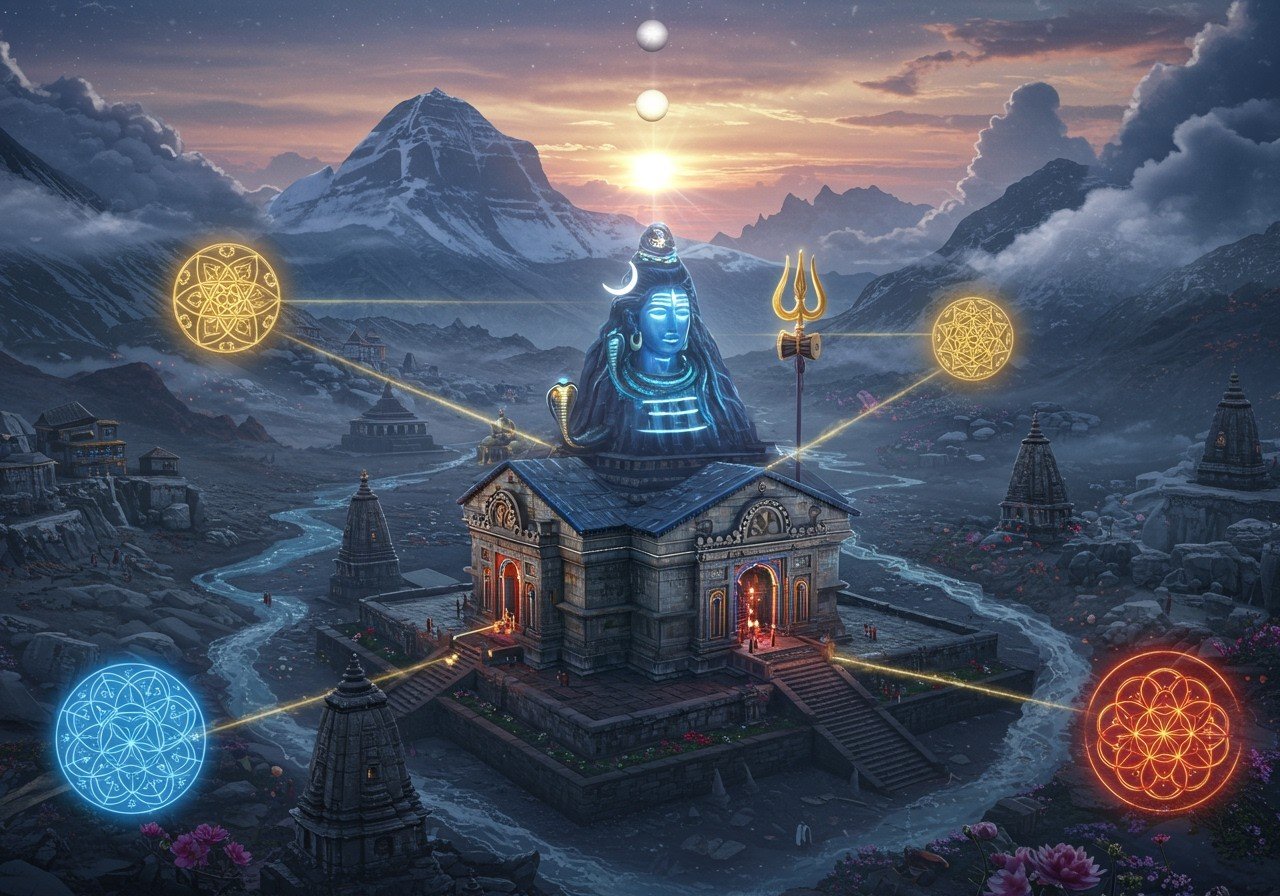
India, a land steeped in spirituality, holds countless temples dedicated to Lord Shiva, each resonating deeply within the hearts of devotees. These sacred spaces aren’t merely structures of brick and stone; they are meticulously positioned according to ancient principles of sacred geography, a practice that intertwines geomancy and cosmology. This thoughtful placement elevates these temples beyond places of worship, transforming them into divine abodes brimming with cultural and spiritual significance.
The Mountain Abode of Shiva
In Hindu cosmology, mountains symbolize the bridge between the earthly and the divine. Majestic peaks like the Himalayas, home to the revered Kedarnath, one of the twelve Jyotirlingas, exemplify this connection. Mountains are seen as the dwelling places of gods, with Mount Kailash holding a special reverence as Lord Shiva’s celestial residence. The arduous journey to these high-altitude temples mirrors the spiritual path towards enlightenment, demanding both physical and spiritual dedication, a testament to deep-rooted cultural traditions. These mountain temples serve as vibrant cultural centers, hosting festivals, gatherings, and nurturing local traditions. You can discover a range of sacred idols for your home altar at poojn.in, bringing a touch of the divine into your daily life.
Shiva’s Presence by the Sacred Rivers
Rivers, the lifeblood of our land, hold immense sanctity in Hinduism, symbolizing purification and nourishment. Prominent Shiva temples, such as the Kashi Vishwanath Temple nestled beside the holy Ganges in Varanasi, grace the banks of these sacred waters. Rivers are revered as the veins of Mother Earth, carrying spiritual energy throughout the land. Rituals performed at these riverside temples often involve cleansing dips and offerings, symbolizing the purification of the soul. From a cosmological perspective, rivers represent the boundless cosmic ocean of consciousness. Such locations naturally evolve into cultural hubs, drawing devotees from all corners of the country and highlighting the profound importance of respecting nature. The preservation of these sites is crucial for both spiritual and ecological well-being. Enhance your riverside rituals with authentic puja items from poojn.in, ensuring a pure and respectful offering.
The Coastal Majesty of Shiva
The convergence of land and sea holds a unique significance in Shiva worship. Temples like the Somnath Temple in Gujarat, standing proudly by the ocean’s edge, embody the vastness of cosmic oceans and the infinite possibilities they represent. The rhythmic ebb and flow of waves mirror the cycles of creation and destruction, a central theme in Shiva’s mythology. Historically, these coastal temples played a crucial role in maritime trade routes, fostering cultural exchange and enriching traditions. Coastal rituals often involve unique offerings to the sea, reflecting age-old customs passed down through generations. Due to their exposed location, preservation efforts are vital to safeguard these coastal temples, ensuring they remain integral to India’s vibrant cultural heritage. Find the perfect offerings for your coastal puja at poojn.in, where tradition meets convenience.
Sacred Geography and Shiva Temples: A Deeper Dive
India’s Shiva temples are more than just architectural wonders; they are portals connecting us to a sacred geography, weaving together ancient wisdom and profound spirituality. Sacred geography invites us to view the Earth as a divine map, where temples mark points of potent spiritual energy.
Temples of the Heights: Shiva’s Mountain Abodes
-
Mountains hold immense spiritual significance in Hindu belief. Picture Kedarnath, nestled high in the Himalayas. These towering peaks are perceived as pathways to the divine, bridging the gap between the earthly and the celestial. Pilgrims undertake arduous journeys across challenging terrains to reach these sacred sites, their physical journey mirroring their inner spiritual quest. The climb itself symbolizes the overcoming of life’s obstacles on the path to enlightenment.
These mountain temples become the beating heart of local culture, hosting vibrant festivals and gatherings that strengthen community bonds. Pooja essentials for your mountain pilgrimage can be found at poojn.in, ensuring you have everything needed for a deeply spiritual experience.
Temples by the Flowing Waters: Shiva’s River Sanctuaries
-
Rivers are revered as purifiers of life in Hindu tradition. Temples like Kashi Vishwanath on the banks of the Ganges tap into this sacred flow. Rivers are viewed as the Earth’s veins, channeling spiritual energy across the land. Rituals performed here are deeply cleansing, with devotees taking holy dips in the sacred waters.
Cosmologically, rivers represent the infinite ocean of consciousness, transforming these temples into focal points for cultural and religious activities. Preserving these riverside sanctuaries is crucial, reflecting a deep reverence for nature’s gifts. You can find traditional holy cosmetics for your riverside rituals at poojn.in, ensuring purity and respect in your practices.
Temples at the Edge of Infinity: Shiva’s Coastal Shrines
-
Coastal Shiva temples like Somnath embody the boundless wonders of the cosmos. The sea symbolizes endless possibilities and the mysteries that lie beyond the horizon. The rhythmic waves echo the continuous cycles of creation and destruction, a powerful theme in Shiva’s mythology. Historically, these coastal temples were integral to maritime trade routes, facilitating cultural exchange and enriching local traditions.
Rituals performed at coastal temples often involve offerings to the sea, a practice rooted in time-honored traditions. Dedicated preservation efforts ensure that these sites withstand the challenges of their coastal location, safeguarding India’s rich cultural heritage. Authentic Shiva lingams for your home shrine are available at poojn.in, allowing you to bring the sacred energy of the temple into your daily life.
Architectural Significance & Design: The Cosmic Blueprint of Shiva Temples
-
Shiva temples are meticulously crafted with profound precision. Vastu Shastra, the ancient Indian science of architecture, serves as the guiding principle, seamlessly integrating cosmic principles into the structural design. This holistic approach considers orientation, geometry (the interplay of squares and circles), and the temple’s relationship with the cosmos.
The Dravidian architectural style, prominent in South Indian temples, showcases breathtaking gopurams (towering pyramidal gateways) and magnificent pillared halls, adorned with intricate sculptures. Essential components like the *Garbhagriha* (sanctum sanctorum), *Shikhara* (tower above the sanctum), *Mandapa* (assembly hall), *Antarala* (antechamber connecting the *Garbhagriha* and *Mandapa*), and the circumambulatory path (*parikrama*) form the core of the temple’s structure, reflecting cosmic harmony and balance.
Symbolism and Cosmology: Decoding the Sacred Language of Shiva Temples
-
The Shiva Lingam, an iconic representation of Lord Shiva, stands as a symbol of divine union, representing the harmonious balance of male and female energies. Some temples are dedicated to the Pancha Bhoota, the five elements – earth, water, fire, air, and space, embodying the fundamental building blocks of creation.
Cosmic alignment adds another layer of intrigue, with certain temples believed to be strategically positioned along ley lines, energy meridians that are thought to channel Earth’s spiritual energy. The Panchamukha Linga, a five-faced lingam, represents the five aspects of Shiva’s cosmic energy, further emphasizing the temple’s connection to the universe.
Poojn.in: Your Companion on the Spiritual Path
At poojn.in, we understand the deep significance of these sacred rituals and the reverence with which they are performed. That’s why we offer a wide selection of authentic puja items, carefully curated to support your spiritual journey. Whether you’re seeking pure copper and brass items for abhishekam, fragrant bel patra and dhatura offerings, sacred rudraksha malas, pure silver items, or authentic vibhuti (sacred ash), we have everything you need to honor Lord Shiva with utmost devotion. Explore our comprehensive Shiva puja sets, designed to simplify your worship, whether at home or in the temple. Each set includes detailed instructions to guide you through each step of the ritual. We prioritize quality and authenticity, ensuring that every item undergoes rigorous checks. Our dedicated team is available to assist you with any questions you may have regarding product selection and usage, reachable via WhatsApp (9476142738) or phone (03369029784). For bulk orders, we offer special packaging and shipping across India. Visit poojn.in or contact us today. Let us be a part of your spiritual practice.
Conclusion: Embracing the Sacred Unity
India’s Shiva temples serve as powerful reminders of the interconnectedness of spirituality, nature, and architecture. These sacred sites, thoughtfully placed across mountains, rivers, and coastlines, are much more than places of worship; they are living testaments to India’s rich cultural and spiritual heritage. They encourage us to cultivate a deep respect for the natural world and the cosmic order it represents. By honoring these sacred spaces, we carry forward a legacy of devotion, community, and reverence for the divine geography that shapes our lives. Embracing this sacred unity allows us to find not only inner peace but also a profound connection to our heritage and traditions.
FAQs: Unveiling the Mysteries of Shiva Temples and Sacred Geography
How are Shiva temples connected to sacred geography? Shiva temples are often situated in locations imbued with deep spiritual meaning. These locations are chosen based on ancient cosmological beliefs, where natural elements like mountains, rivers, and seas hold sacred significance.
Why are so many Shiva temples located on mountains? Mountains are perceived as being closer to the heavens, making them powerful spiritual sites. Mount Kailash is revered as the abode of Lord Shiva, thus making mountain locations particularly auspicious for Shiva temples.
What is the significance of Shiva temples situated by rivers? In Hindu tradition, rivers are seen as purifiers and life-givers. Temples by rivers symbolize the flow of divine energy and offer a serene setting for worship and meditation.
Why are some Shiva temples located near the sea? The sea embodies vastness and eternity, mirroring the infinite nature of Shiva. Coastal temples allow devotees to experience the magnificence of nature, deepening their spiritual connection.
How do these temple locations reflect cosmological beliefs? The locations of Shiva temples are carefully chosen to align with natural elements believed to represent cosmic principles. Mountains, rivers, and seas each hold symbolic meanings that reflect different facets of the universe and the nature of Lord Shiva.
Are there specific geographical patterns followed in the placement of Shiva temples? Yes, Shiva temples frequently adhere to specific patterns, such as alignment with cardinal directions or natural landmarks, which are believed to harness and amplify spiritual energies.
Do all Shiva temples adhere to these geographical beliefs? While many Shiva temples align with these principles of sacred geography, not all do. Some are built in urban areas for greater accessibility. However, even these urban temples often incorporate elements like sacred groves or water bodies to maintain a connection to spiritual significance.


